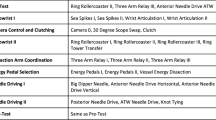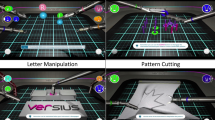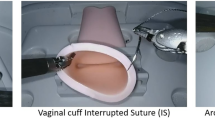Abstract
Introduction
This study aimed to develop a training curriculum to evaluate the basic robotic skills necessary to reach an 80 % preset proficiency score and correlate the level of surgical experience with the overall performance obtained using the da Vinci Surgical Skills simulator.
Methods
Twenty-two participants (4 faculty, 4 senior, and 14 junior residents) were enrolled in a 4-week robotic training curriculum developed at our institution. A set of seven robotic skills were selected based on the manufacturer’s exercise primary endpoint. During their pretesting session, participants completed one trial of each of the seven simulated exercises. In two individual sessions over a 2 week period, trainees practiced a different set of exercises that evaluated the same basic robotic skills assessed during pretesting with the objective of reaching an overall score of 80 % on two consecutive attempts. If proficiency was not achieved, then a maximum of six trials per exercise was allowed before advancing to the next skill. During their fourth week of training, participants completed a post-testing session with the same set of exercises used during pretesting. Participants’ overall performance and various metrics were recorded in an online database for further analysis.
Results
A significant skills gain from pre- to post-test was observed for each of the seven basic robotic skills regardless of participant’s level of training (p < .001). Interestingly, participants only achieved an overall score of 80 % or more in only five of the seven exercises. No statistical difference in gain of skills was found between groups suggesting robotic skills development is independent of level of prior surgical expertise.
Conclusion
A dedicated virtual reality robotic training curriculum significantly improves the seven basic robotic surgical skills necessary to operate the da Vinci Si surgical console. Six training trials appear to be insufficient to reach proficiency levels on more advanced skills.



Similar content being viewed by others
References
Oleynikov D (2008) Robotic surgery. Surg Clin North Am 88:1121–1130
Giri S, Sarkar D (2012) Current status of robotic surgery. Indian J Surg 74(3):242–247
Yates D, Vaessen C, Roupret M (2011) From Leonardo to da Vinci: the history of robot-assisted surgery in urology. BJU Int 108:1708–1714
Derossis AM, Fried GM, Abrahamowicz M, Sigman HH, Barkun JS, Meakins JL (1998) Development of a model for training and evaluation of laparoscopic skills. Am J Surg 175:482–487
Fraser SA, Klassen DR, Feldman LS, Ghitulescu GA, Stanbridge D, Fried GM (2003) Evaluating laparoscopic skills: setting the pass / fail score for the MISTELS system. Surg Endosc 17(6):964–967
Fried GM, Feldman LS, Vassiliou MC, Fraser SA, Stanbridge D, Ghitulescu G, Andrew CG (2004) Proving the value of simulation in laparoscopic surgery. Ann Surg 240:518–528
Scott DJ, Ritter EM, Tesfay ST, Pimentel EA, Nagji A, Fried GM (2008) Certification pass rate of 100 % for fundamentals of laparoscopic surgery skills after proficiency based-training. Surg Endosc 22:1887–1893
Kelly DC, Margules AC, Kundavaram CR, Narins H, Gomella LG, Trabulsi EJ, Lallas CD (2012) Face, content, and construct validation of the da Vinci Skills Simulator. Urology 79:1068–1072
Hung AJ, Zehnder P, Patil MB, Cai J, Ng CK, Aron M, Gill IS, Desai MM (2011) Face, content, and construct validity of a novel robotic surgery simulator. J Urol 186:1019–1024
Finnegan KT, Meraney AM, Staff I, Shichman SJ (2012) da Vinci Skills Simulator Construct Validation Study: correlation of prior robotic experience with overall score and time score simulator performance. Urology 80:330–336
Dulan G, Rege RV, Hogg DC, Gilberg-Fisher KK, Tesfay ST, Scott DJ (2012) Content and face validity of a comprehensive robotic skills training program for general surgery, urology, and gynecology. Am J Surg 203:535–539
Joint American Educational Research Association (1999) The Standards for Educational and Psychological Testing. American Educational Research Association, Washington, DC
Perrenot C, Perez M, Tran N, Jehl JP, Felblinger J, Bresler L, Hubert J (2012) The virtual reality simulator dV-Trainer is a valid assessment tool for robotic surgical skills. Surg Endosc 26:2587–2593
Hung AJ, Patil MB, Zehnder P, Cai J, Ng CK, Aron M, Gill IS, Desai MM (2012) Concurrent and predictive validation of a novel robotic surgery simulator: a prospective, randomized study. J Urol 187:630–637
Dulan G, Rege RV, Hogg DC, Gilberg-Fisher KM, Arain NA, Tesfay ST, Scott DJ (2012) Developing a comprehensive, proficiency-based training program for robotic surgery. Surgery 152:477–488
Dulan G, Rege RV, Hogg DC, Gilberg-Fisher KM, Arain NA, Tesfay ST, Scott DJ (2012) Proficiency-based training for robotic surgery: construct validity, workload, and expert levels for nine inanimate exercises. Surg Endosc 26(6):1516–1521
Goh AC, Goldfarb DW, Sander JC, Miles BJ, Dunkin BJ (2012) Global evaluative assessment of robotic skills: validation of a clinical assessment tool to measure robotic surgical skills. J Urol 187(1):247–252
Lucas SM, Gilley DA, Joshi SS, Gardner TA, Sundaram CP (2011) Robotics training program: evaluation of the satisfaction and the factors that influence success of skills training in a resident robotics curriculum. J Endourol 25(10):1669–1674
Lyons C, Goldfarb D, Jones SL, Badhiwala N, Miles B, Link R, Dunkin BJ (2013) Which skills really matter? proving face, content, and construct validity for a commercial robotic simulator. Surg Endosc 27(6):2020–2030
Patel A, Patel M, Lytle N, Toro JP, Medbery RL, Bluestein S, Perez SD, Sweeney JF, Davis SS, Lin E (2014) Can we become better robot surgeons through simulator practice? Surg Endosc 28:847–853
Ericson KA, Krampe RT, Tesch-Romer C (1993) The role of deliberate practice in the acquisition of expert performance. Psychol Rev 100(3):363–406
Willis RE, Richa J, Oppeltz R, Nguyen P, Wagner K, Van Sickle KR, Dent DL (2012) Comparing three pedagogical approaches to psychomotor skills acquisition. Am J Surg 203(1):8–13
Disclosures
Dr. Gomez is a member of the resident education committee for SAGES. Dr. Van Sickle has received honorarium as a consultant for Covidien Ltd. Dr. Willis has no conflicts of interest or financial ties to disclose.
Author information
Authors and Affiliations
Corresponding author
Rights and permissions
About this article
Cite this article
Gomez, P.P., Willis, R.E. & Van Sickle, K.R. Development of a virtual reality robotic surgical curriculum using the da Vinci Si surgical system. Surg Endosc 29, 2171–2179 (2015). https://doi.org/10.1007/s00464-014-3914-y
Received:
Accepted:
Published:
Issue Date:
DOI: https://doi.org/10.1007/s00464-014-3914-y




